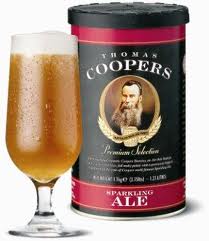Kit: Coopers Original Series Lager
Plan: Hop a Coopers Lager kit with a little Mittelfruh for a Boston lager style. Use Nottingham for a clean lager taste. Looking forward to doing this one. Bulk-prime with 150g dextrose.
500g light spraymalt
500g beer kit enhancer 1
Hop Schedule
15 mins – 25g Hallertauer Mittelfruh
5 mins – 25g Hallertauer Mittelfruh
Dry Hop – 25g Hallertauer Mittelfruh
Music: Electric Light Orchestra
OG: 1.040
Expected FG: 1.010
Edit**
Bottling Date: 08/05/2011
Actual FG: 1.010
Made up kit using the usual procedures but using a large Le Creuset as a brew pot. Worked quite well, I have to say. Dissolved about 300g of the spraymalt in 2 litres of water, which I later topped up with another litre after I put the hops in. Added hops according to the above schedule. There was lots of yellow bits in the resulting wort (lupulin?). Had a problem with my new strainer funnel. 50g of hops is a huge volume when fully hydrated and will not fit in this tiny funnel. As a result, I spilled a few hops into the fermenter. My only other option is to get a large sieve as I’m planning doing hops of this volume in the future. That was the only “incident”.
Fermentation took off within an hour! And was kicking off with gusto by the next morning. No big krausen though, about 2 inches. A different type of fermentation with the Nottingham yeast. It looks like the beer is fizzing! Like a big pint of beer really.
26/04/2011 – Looks like fermentation is just about to stop, still a slight fizz on top though, and some brown yeast floating on top too. Will rack to secondary at the weekend, following a gravity reading.
29/04/2011 – This thing is still fizzing! It’s good really, because the yeast is taking out a lot of the residual sweetness, hopefully leaving a cleaner, lager-like flavour. I think it’s starting to clear a little too, but that could be the morning sun shining through the fermenter. Still some hop particles floating on top and lots of clumps of brown yeast.
02/05/2011 – Racked to secondary after 11 days in primary. Racked onto 25g Mittelfruh hops, contained in a sanitised muslin bag. Still some tiny bubbles coming from the primary FV before I bottled. Gravity read 1.010. Taste was okay, a little muddy/yeast perhaps but some nice potential there and was quite lager-like.
07/05/2011 – Bottled this bad boy. Only 5 days on the dry hops but they’ll have done a good job. Need to look at my siphoning technique and get my secondary FV down lower. Must remember to put a cloth under the FV on the counter to stop it slipping. I ended up disturbing yeast that would have stuck to the bottom of the FV if I hadn’t been so cack-handed in trying to tilt the FV to get the last couple of litres out. Ended up leaving about 2 litres in the bottom of the FV when I was racking to the bottling bucket! Bottled 34 bottles. Good smell but I didn’t have a taste. Looking forward to sampling this one. I’m guessing it might condition a bit faster as the fermentables were 50% BKE. I’ll try a bottle after 1 month.
12/05/2011 – Think it’s carbonated already. Definitely some pressure in the bottles. And plenty of fizz when I try to upset the yeast back into suspension.
22/05/2011 – Moved to shed after 2 weeks at room temperature. Plenty of fizz in it I think. I put one bottle in the fridge for a couple of nights and could tell the difference in the amount of CO2 absorbed when compared with one of the other bottles. Lots of smaller bubbles shaken out of suspension. I thought better of drinking it though and moved it out to the shed along with all the others.
01/06/2011 – Tried one. Just over three weeks in the bottle. Tastes very green. There’s an overly fruity and slightly plastic flavour on this. Also plenty of chill haze or sediment. Not entirely pleasant, but I still drank most of it. There’s a strong Hallertauer flavour which makes the beer reminiscent of a pale ale so it’s possible I’ve overdone the hops on this one. Good head retention though. Will wait another month before trying another.
07/08/2011 – Now that I understand a bit more about home brewing I can see it was a bit stupid to expect anything like “Boston Lager” by simply adding a shitload of hops to this kit. First of all, I added far too much hops. I reckon that by simply adding a 25g hop tea would have freshened up this kit considerably. Lagers, even “faux lagers, are never hopped heavily like this. The result more resembled a hoppy pale ale than a lager. The Notty yeast did a fine job in producing a clean tasting beer, but a lager it ain’t.
Saying that, the beer was very drinkable and was a particular hit with the missus.



